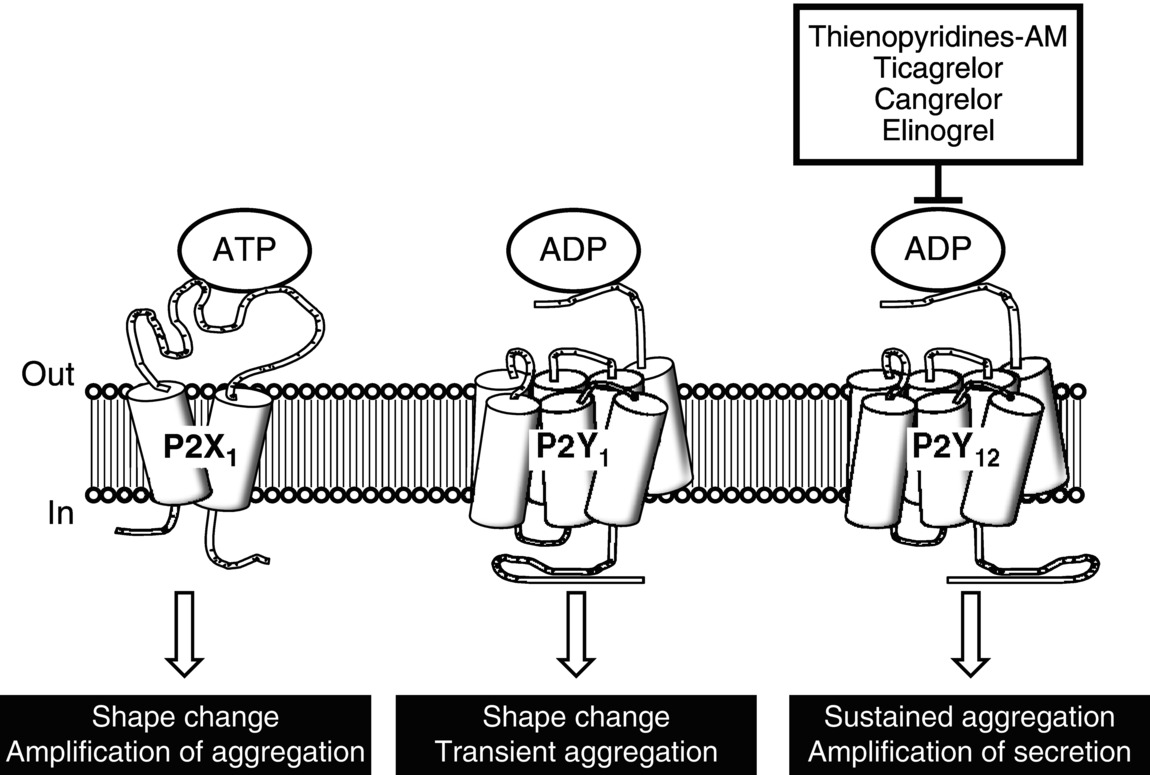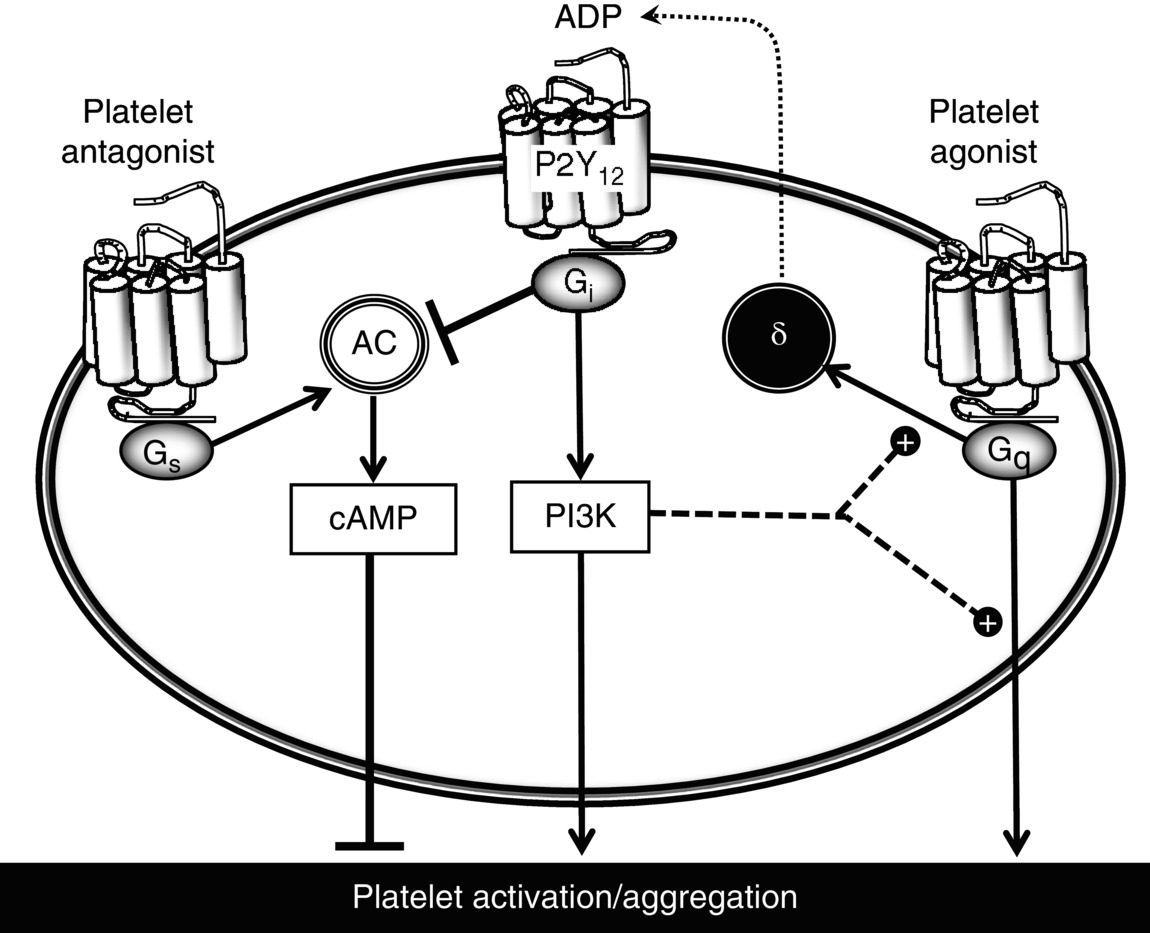3 Marco Cattaneo Ospedale San Paolo, Università degli Studi di Milano, Milano, Italy Purine and pyrimidine nucleotides are extracellular signaling molecules that regulate the function of virtually every cell in the body. They interact with P2 receptors, which are divided into two subfamilies: P2Y receptors, seven-membrane spanning proteins coupled to G proteins, and P2X receptors, ligand-gated ion channels [1]. Eight P2Y receptors have been identified so far: P2Y1, P2Y2, P2Y4, P2Y6, P2Y11, P2Y12, P2Y13, and P2Y14. They can be subdivided into adenine nucleotide- and uracil nucleotide-preferring receptors: the former (P2Y1, P2Y11, P2Y12, and P2Y13) mainly respond to adenosine diphosphate (ADP) and adenosine triphosphate (ATP). From a phylogenetic and structural point of view, two distinct P2Y receptor subgroups have been identified: the Gq-coupled subtypes (P2Y1, P2Y2, P2Y4, P2Y6, and P2Y11) and the Gi-coupled subtypes (P2Y12, P2Y13, and P2Y14) [1]. Seven P2X receptors have been identified, P2X1–P2X7, which are primarily ATP receptors [1]. Human platelets express three distinct P2 receptors (Figure 3.1): P2Y1 and P2Y12, which interact with ADP, and P2X1, which interacts with ATP, with the following order of expression – P2Y12 >> P2X1 > P2Y1 [2]. Figure 3.1 Simplified schematic representation of the effects of the interaction of ATP and ADP with platelet P2 receptors (P2X1, P2Y1, P2Y12) in platelet function. Inhibitors have been developed for each receptor, but only the P2Y12 receptor inhibitors are shown, because they are already used in clinical practice, or are in development, as antithrombotic drugs: the AM of thienopyridines, ticagrelor, cangrelor, and elinogrel. ADP is a weak platelet agonist. As such, it only induces shape change and reversible aggregation in human platelets, while the secretion of platelet δ-granules constituents and the ensuing secondary aggregation that are observed following stimulation with ADP of normal platelet-rich plasma (PRP) are triggered by thromboxane (TX)A2, whose synthesis is stimulated by platelet aggregation [3]. This phenomenon is greatly enhanced when the concentration of plasma Ca2+ is artifactually decreased, such as in citrate PRP. ADP plays a key role in platelet function because, when it is secreted from δ-granules, it amplifies the platelet responses induced by other platelet agonists and stabilizes platelet aggregates (Figure 3.2) [3, 4]. Transduction of the ADP-induced signal involves inhibition of adenylyl cyclase (AC) and a concomitant transient rise in the concentration of cytoplasmic Ca2+. Figure 3.2 Central role of P2Y12 in platelet activation and aggregation. ADP, by interacting with P2Y12, a seven-transmembrane receptor that is coupled to the inhibitory G protein Gi, induces platelet aggregation and amplifies the aggregation response that is induced by other agonists (but also by ADP itself, which interacts also with its other platelet receptor, P2Y1, not shown in this cartoon). In addition, P2Y12 stabilizes the platelet aggregates (not shown in this cartoon) and amplifies the secretion of platelet dense granules (δ) stimulated by secretion-inducing agonists (which are coupled to Gq). Although P2Y12 is coupled to inhibition of AC through Gi, this function is not directly related to P2Y12-mediated platelet activation. However, it could have important implications in vivo, where platelets are exposed to the natural platelet antagonists, such as prostacyclin or adenosine, which inhibit platelet activation/aggregation by increasing platelet cAMP through activation of AC mediated by Gs: inhibition of AC by P2Y12 counteracts the inhibitory effect of these platelet antagonists, thereby favoring platelet activation and the formation of platelet aggregates in vivo. solid line + arrow, activation; truncated solid line, inhibition; dashed line ending with a (+), amplification; dotted line + arrow, secretion. Upon platelet exposure to ADP, the Gq-coupled P2Y1 receptor mediates a transient rise in cytoplasmic Ca2+, platelet shape change, and rapidly reversible aggregation, and the Gi-coupled P2Y12 receptor mediates inhibition of AC and amplifies the platelet aggregation response [3, 4]. Concomitant activation of both the Gq and Gi pathways by ADP is necessary to elicit normal aggregation (Figure 3.1) [5]. The importance of concurrent activation of the Gq and Gi pathways for full platelet aggregation is highlighted by the observations that normal aggregation responses to ADP can be restored by epinephrine, which is coupled to an inhibitory G protein, Gz, in P2Y12-deficient platelets, and by serotonin, which is coupled to Gq, in P2Y1 knockout (KO) platelets [3]. ATP, through its interaction with P2X1
Platelet Receptors and Drug Targets: P2Y12
P2 receptors

Roles of adenine nucleotides in platelet function

![]()
Stay updated, free articles. Join our Telegram channel

Full access? Get Clinical Tree


